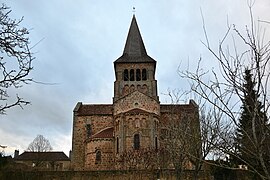Franchesse
The issue of Franchesse is a topic that has generated great interest and controversy in recent times. With different approaches and perspectives, Franchesse has been the subject of debate and research in various areas of knowledge. From its impact on society to its implications at the individual level, Franchesse has captured the attention of academics, specialists and ordinary people. In this article, we will explore different aspects related to Franchesse, analyzing its relevance and unraveling its possible consequences. Additionally, we will examine how Franchesse has shaped and will continue to shape the current landscape, offering a comprehensive view of this important topic.
You can help expand this article with text translated from the corresponding article in French. (December 2008) Click for important translation instructions.
|
Franchesse | |
|---|---|
 The church in Franchesse | |
| Coordinates: 46°38′15″N 3°02′15″E / 46.6375°N 3.0375°E | |
| Country | France |
| Region | Auvergne-Rhône-Alpes |
| Department | Allier |
| Arrondissement | Moulins |
| Canton | Bourbon-l'Archambault |
| Intercommunality | Bocage Bourbonnais |
| Government | |
| • Mayor (2020–2026) | Gérard Vernis[1] |
Area 1 | 40.24 km2 (15.54 sq mi) |
| Population (2022)[2] | 465 |
| • Density | 12/km2 (30/sq mi) |
| Time zone | UTC+01:00 (CET) |
| • Summer (DST) | UTC+02:00 (CEST) |
| INSEE/Postal code | 03117 /03160 |
| Elevation | 204–322 m (669–1,056 ft) (avg. 319 m or 1,047 ft) |
| 1 French Land Register data, which excludes lakes, ponds, glaciers > 1 km2 (0.386 sq mi or 247 acres) and river estuaries. | |
Franchesse (French pronunciation: [fʁɑ̃ʃɛs]) is a commune in the Allier department in central France. The linguist Frantz Brunet (1879–1965) was born in Franchesse.
Population
| Year | Pop. | ±% p.a. |
|---|---|---|
| 1968 | 675 | — |
| 1975 | 552 | −2.83% |
| 1982 | 539 | −0.34% |
| 1990 | 532 | −0.16% |
| 1999 | 451 | −1.82% |
| 2009 | 447 | −0.09% |
| 2014 | 459 | +0.53% |
| 2020 | 479 | +0.71% |
| Source: INSEE[3] | ||
See also
References
- ^ "Répertoire national des élus: les maires". data.gouv.fr, Plateforme ouverte des données publiques françaises (in French). 2 December 2020.
- ^ "Populations de référence 2022" (in French). The National Institute of Statistics and Economic Studies. 19 December 2024.
- ^ Population en historique depuis 1968, INSEE
Wikimedia Commons has media related to Franchesse.


